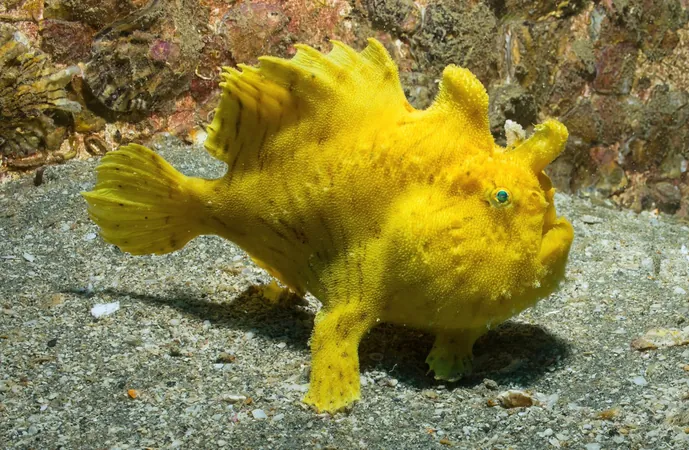
Frogfish: Ocean's Master Predators with Built-in Fishing Rods
2024-12-15
Author: Wei
Introduction
Beneath the shimmering surface of our oceans lies a remarkable creature that has perfected the art of deception: the frogfish. A captivating member of the anglerfish family, these extraordinary beings have undergone unique evolutionary transformations that allow them to thrive in a variety of marine settings while showcasing their cunning hunting techniques.
Nature’s Living Lure
Frogfish are well-known for their ability to camouflage themselves, blending in with their surroundings so seamlessly that they become nearly undetectable to the small fish and crustaceans they prey upon. This remarkable disguise is their secret weapon. The hunting tactics they employ are akin to a game of stealth, as they patiently wait for unsuspecting victims to wander too close.
The Ingenious Design of the Dorsal Fins
What sets frogfish apart from other predators in the ocean is their specialized dorsal fins. These fins serve a variety of crucial roles in their hunting strategy. The dorsal fins toward the center of their bodies not only help with stability during swimming but also allow for threatening displays. However, it's the front dorsal fin, known as the illicium, that steals the spotlight. This fishing rod-like structure features an enticing lure, or “eska,” which mimics the appearance of a clam worm—a delicacy for many fish.
Using their illicium, frogfish enact a captivating performance, waving their eska to attract prey. Unfortunately for the fish lured in, this bait is all too real, leading to a swift and decisive capture by the frogfish.
The Science Behind the Hunt
A groundbreaking study spearheaded by researchers from Nagoya University has revealed the astonishing neuronal mechanisms that propel the frogfish's unique hunting behavior. Led by Professor Naoyuki Yamamoto, the team identified specialized motor neurons called "fishing motor neurons" in the illicium. These neurons play a pivotal role in controlling the illicium's movements, distinctly separate from those that manage the other dorsal fins.
Through innovative tracer injections, the researchers traced the connections of these motor neurons within the frogfish's spinal cord. They were amazed to find that these neurons are located in a different area than those controlling the traditional dorsal fins, suggesting a fascinating evolutionary shift.
Evolution's Hidden Lessons
The implications of this research extend beyond the depths of the ocean. Professor Yamamoto suggests that the findings could offer insights into the evolutionary pathways of other species, including humans. By comparing frogfish motor neuron organization with that of other vertebrates, the study highlights an evolutionary continuity that echoes across species.
“Invertebrates may not share our limbs, yet there are intriguing similarities in motor neuron distribution," noted Yamamoto. "Such studies can catalyze further research into the complex evolution of motor functions across the animal kingdom.”
In a world where more is discovered every day about life's evolution, the study of frogfish and their intricately designed hunting strategies serves not only as a peek into a mesmerizing underwater realm but also as a reminder of the interconnected pathways that shape all life.
Conclusion and Call to Action
The full findings of this fascinating study can be explored further in the Journal of Comparative Neurology—putting the spotlight on just how intricate and artful the ballet of life can truly be. For more captivating insights into the mysteries of the ocean and beyond, subscribe to our newsletter for articles that dive deep into the wonders of nature!


 Brasil (PT)
Brasil (PT)
 Canada (EN)
Canada (EN)
 Chile (ES)
Chile (ES)
 España (ES)
España (ES)
 France (FR)
France (FR)
 Hong Kong (EN)
Hong Kong (EN)
 Italia (IT)
Italia (IT)
 日本 (JA)
日本 (JA)
 Magyarország (HU)
Magyarország (HU)
 Norge (NO)
Norge (NO)
 Polska (PL)
Polska (PL)
 Schweiz (DE)
Schweiz (DE)
 Singapore (EN)
Singapore (EN)
 Sverige (SV)
Sverige (SV)
 Suomi (FI)
Suomi (FI)
 Türkiye (TR)
Türkiye (TR)